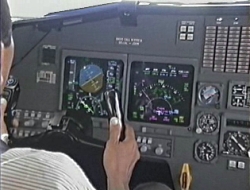Across an area about 2700 Km
Ocean Currents
There are two type of Ocean Currents:
• Surface Currents--Surface Circulation
These waters make up about 10% of all the water in the ocean.
These waters are the upper 400 meters of the ocean.
• Deep Water Currents--Thermohaline Circulation
These waters make up the other 90% of the ocean
These waters move around the ocean basins by density driven forces and gravity.
The density difference is a function of different temperatures and salinity
These deep waters sink into the deep ocean basins at high latitudes where the temperatures are cold enough to cause the density to increase.
Ocean Currents are influenced by two types of forces
1. Primary Forces--start the water moving
The primary forces are:
1. Solar Heating
2. Winds
3. Gravity
4. Coriolis
Earth's gravity field - exaggerated
2. Secondary Forces--influence where the currents flow
1. Surface Circulation
Solar heating cause water to expand. Near the equator the water is about 8 centimeters high than in middle latitudes. This cause a very slight slope and water wants to flow down the slope.
Winds blowing on the surface of the ocean push the water. Friction is the coupling between the wind and the water's surface.
A wind blowing for 10 hours across the ocean will cause the surface waters to flow at about 2% of the wind speed.
Water will pile up in the direction the wind is blowing.
Gravity will tend to pull the water down the "hill" or pile of water against the pressure gradient.
But the Coriolis Force intervenes and cause the water to move to the right (in the northern hemisphere) around the mound of water.
Indian Ocean
Remarkable features
Surface: 75 000 000 km2
Maximum depth: 4 000 m
Currents : Agulhas current (warm)
Seas : Oman, Bengali Gulf, Andaman Sea, Timor
Oscillation phenomena: Indian Ocean Dipole
North Indian Ocean circulation
South Indian Ocean circulation
Reference
University of Southern California
Department of Earth Sciences
Columbia University, Vol. 23, n° 11, DEC 5, 1997
NASA - JPL’S OCEAN SCIENCE, VISIT THE EARTH/OCEAN MOTION










Nenhum comentário:
Postar um comentário